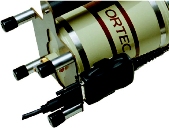 |
GEM P-type Coaxial High Purity Germanium (HPGe) Radiation Detectors The majority of gamma spectroscopy applications such as those found in counting laboratories involve the energy range ~40 keV upward. ORTEC GEM detectors are designed to cover this All GEM Series feature:
ORTEC offers GEM Series HPGe detectors with relative efficiencies from 10% to 150% and beyond. The detectors are manufactured from ORTEC-grown germanium crystals processed in our advanced manufacturing facility in Oak Ridge, TN. The detectors are fabricated from P-type germanium with an outer contact of diffused Li and an inner contact of ion-implanted boron. ORTEC maintains a stocklist of GEM detectors. Some of these have “super specifications,” that is energy resolution and/or efficiency better than the usual GEM warranted specifications. |
 |
PROFILE GEM P-type Coaxial and Semi-Planar HPGe Radiation Detectors ORTEC PROFILE Series of P-Type High Purity Germanium (HPGe) detectors match the crystal dimension to your application for optimal counting geometry and results. PROFILE GEM Series detectors feature:
The ORTEC PROFILE Series of P-type High Purity Germanium (HPGe) detectors offers specific crystal dimensions from which you can choose the best solution in YOUR application. Nominal relative efficiency specifications (warranted for C Series) are provided to help relate relative efficiency to terms of crystal dimensions. The efficiency is measured according to the IEEE standard. |
 |
Gamma-X (GMX) N-type High Purity Germanium (HPGe) Coaxial Radiation Detectors The GAMMA-X detector is a coaxial Germanium (Ge) detector with an ultra-thin entrance window. While most coaxial detectors have entrance windows from 500- to 1000-μm thick, the entrance window of the GAMMA-X detector is a 0.3-μm-thick, ion-implanted contact, extending the lower range of useful energies to around 5 keV. Ion implantation results in a totally stable contact which will not deteriorate with repeated cycling. Moreover, N-type HPGe detectors have been shown to be resistant All GAMMA-X Series detectors feature:
GAMMA-X Series detectors are manufactured from ORTEC-grown germanium crystals processed in our advanced manufacturing facility in Oak Ridge, TN. The detectors are fabricated from N-type germanium with an inner contact of diffused Li and an outer, ultra thin, contact of ion-implanted boron. |
|
|
GWL (Well) P-type Reverse Coaxial Radiation DetectorsORTEC GWL Series High-Purity Germanium (HPGe) Well Detectors are a good solution for low level counting of small samples. The unique ion-implanted detector GWL (Well) P-type Reverse Coaxial Radiation Detectors well has an ultra-thin dead layer (only 0.3 μm thick), and therefore provides the most extensive useful energy range (10 keV to 10 MeV). Unlike other Well detectors that have a hole all the way through the germanium crystal, ORTEC’s Well Detectors have a “blind hole” with at least 5 mm of active germanium at the bottom of the hole. This near 4 π geometry provides the maximum absolute counting efficiency available. The large well (1.55-cm diameter and 4.0-cm-long) accommodates an extensive range of sample sizes. Like all of ORTEC’s HPGe photon detectors, the HPGe Well detector may be stored or cycled repeatedly to room temperature without performance degradation. GWL Series feature:
|
|
|
GLP Series Planar HPGe Low Energy Radiation Detectors
The ORTEC GLP Series Planar Low-Energy Photon Spectrometer (LEPS) is a small-area, high-purity germanium photon spectrometer for use in applications over the energy range from 3 to ~300 keV. Available in diameters from 6 to 36 mm, the LEPS offers exceptional energy resolution for low and intermediate energies. At low energies in nuclear structure physics GLP detectors are irreplaceable because of their excellent timing performance. |
 |
SMART-1 Detector
ORTEC’s unique SMART-1 detector interface module is a new technology for the preamplifier and electronics interface. SMART-1 detectors contain a microprocessor that monitors the state of health of a detector at all times. Crystal temperature, preamplifier power (±12 and ±24), high voltage level and overload status are all monitored periodically while data is being acquired. If any single parameter fails, a latched bit is set. At the end of the measurement, SMART-1 enabled electronics (digiDART for instance) poll the state-of-health bit and if it is latched, the operator is warned that a parameter had exceeded limits during some part of the measurement. This feature ensures that the data acquired is of the highest possible integrity. |
 |
905 Series NaI(Tl) Scintillation Detectors
The high Z of iodine in NaI(Tl) crystals result in high efficiency for gamma-ray detection. Resolution for a 3-inch diameter by 3-inch length crystal is typically about 7% for 137Cs and slightly worse for larger sizes. The light decay time constant for a NaI(Tl) crystal is about 0.23 ms. Typical charge-sensitive preamplifiers translate this into an output voltage pulse with a rise-time of about 0.5 ms. Fast coincidence measurements cannot achieve the very short resolving times that are possible for plastic scintillators, especially at low gamma-ray energies. The Model 905 Series offers various sizes of Nal(TI) detectors. 905-1 (1” x 1”): 0.17 @0.5 MeV and 0.09 @2.0 MeV |


